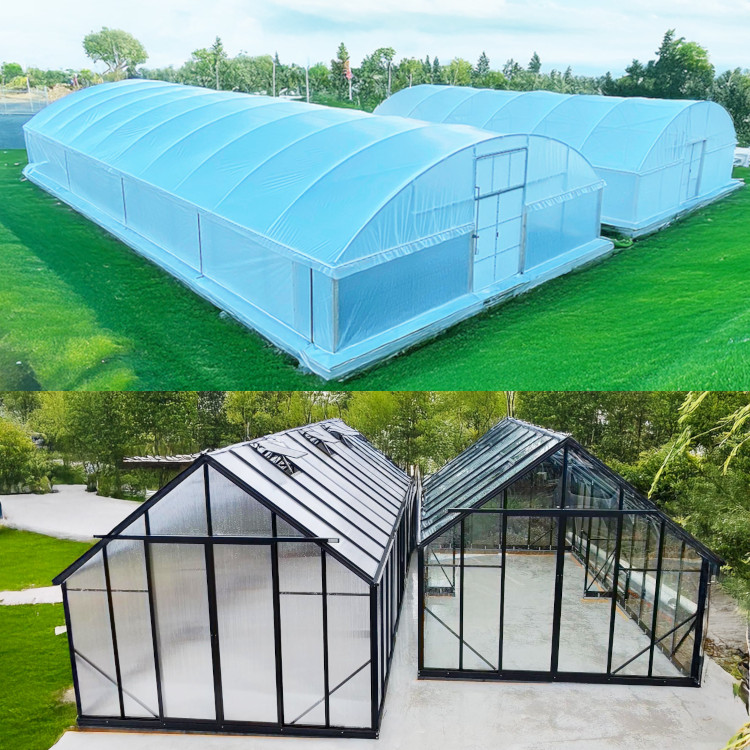Greenhouses – whether polytunnels, glass, polycarbonate, or mini models – offer an ideal environment for growing plants, fruits, and herbs year-round. However, during the hot summer months, overheating can become a significant challenge. High temperatures can damage plants, stunt growth, and even damage your yield completely if not addressed properly.
To maintain a healthy environment for your plants, it is important to take proactive steps to regulate the temperature inside your greenhouse. Here are some important steps that you can take to prevent the greenhouse from overheating.
 Let’s explore different options that can be used to control temperature inside a polytunnel.
Let’s explore different options that can be used to control temperature inside a polytunnel.
Install Ventilation Systems to Regulate Temperature
Proper ventilation is the foundation of any greenhouse cooling strategy. Without adequate airflow, heat builds up rapidly, that can harm your plants. Here are ways to improve ventilation:
- Vents: Equip your greenhouse with roof vents, side vents, or roll-up sides to allow hot air to escape and cooler air to flow in. Roof vents are especially effective as they leverage the fact that hot air naturally rises.
- Use Doors Strategically: Open the greenhouse doors during the hottest parts of the day to encourage cross-ventilation. This is particularly effective in smaller greenhouses or mini-greenhouses.
- Automatic Vent Openers: Automated vents can sense temperature changes and adjust accordingly, saving you the trouble of manually managing airflow while ensuring your plants remain in a stable environment.
Whether you’re managing a polytunnel with roll-up sides or a glass greenhouse with roof vents, ensuring constant airflow is key to preventing overheating.
Use Shade Cloths for Light Control
Shade cloths are one of the most effective tools for blocking excessive sunlight and reducing heat inside your greenhouse.
- Choose the Right Shade Percentage: Shade cloths are available in different densities (e.g., 30%, 50%, 70%). For hot climates, a 50–70% shade cloth is ideal for protecting your plants while ensuring they receive enough light for photosynthesis.
- Install Properly: Secure the shade cloth over your greenhouse frame, ensuring it doesn’t block ventilation openings.
- Seasonal Adjustments: Remove shade cloths during cooler months to maximise light exposure.
Sage Horticultural offers durable, high-quality shade cloths designed for Australian conditions.
Mulch Your Soil
Mulching is a simple yet effective way to protect your greenhouse plants from the stress of high temperatures.
- Organic Mulch: Use natural materials like straw, wood chips, or shredded leaves to retain moisture and regulate soil temperature. Organic mulch also improves soil fertility.
- Plastic Mulch: Reflective plastic mulch helps redirect sunlight away from the soil, keeping it cooler.
Mulching is an excellent way to minimise temperature fluctuations and maintain stable growing conditions for plants in any type of greenhouse.
Incorporate Mist Systems for Evaporative Cooling
Mist systems are an efficient solution for reducing temperature and increasing humidity inside your greenhouse.
- Misting Systems: Set up misting nozzles or hoses that release fine water sprays during the hottest parts of the day. The evaporative cooling effect lowers the temperature and creates a more comfortable environment for your plants.
- Drip Irrigation: Use a drip irrigation system to keep the soil moist and plants hydrated without the risk of overwatering.
Mist systems are especially beneficial for polytunnels and greenhouses in arid regions, where high temperatures can quickly dry out the air.
Use Cooling Fans for Air Circulation
Fans are a vital addition to larger greenhouses or during extreme heat conditions. They help circulate air and prevent hot spots inside the structure.
- Exhaust Fans: Use exhaust fans to pull hot air out of your greenhouse.
- Oscillating Fans: Place oscillating fans inside the greenhouse to evenly distribute cooler air.
By combining fans with other cooling measures, such as shade cloths and misting systems, you can create a much more hospitable environment for your plants.
Greenhouse-Specific Strategies
Different types of greenhouses may require unique approaches to manage overheating effectively:
- Polytunnels: Roll-up sides are highly effective for ventilation. Use shade cloths on the roof and mulch the soil to control heat.
- Glass Greenhouses: Consider automated vent openers and cooling fans to maintain a steady temperature. Shade cloths or whitewashing the glass can also reduce heat absorption.
- Polycarbonate Greenhouses: Polycarbonate retains heat more efficiently than glass, making shade cloths and misting systems critical for temperature control.
- Mini Greenhouses: These can overheat quickly due to their small size. Frequent venting and shade cloth application are essential to prevent heat build-up.
Get Professional Help From How Sage Horticultural
At Sage Horticultural, we understand the challenges gardeners face in maintaining optimal temperatures in their polytunnels. We offer a wide range of products to help you manage heat effectively, including:
- High-quality shade cloths.
- Advanced irrigation and misting kits.
- Temperature monitoring tools and thermometers.
By using these products, you can create a comfortable environment for your plants and enjoy a productive growing season.